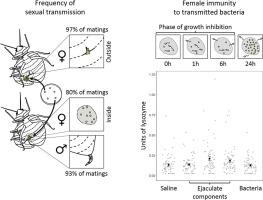当前位置:
X-MOL 学术
›
J. Insect Physiol.
›
论文详情
Our official English website, www.x-mol.net, welcomes your
feedback! (Note: you will need to create a separate account there.)
Female immunity in response to sexually transmitted opportunistic bacteria in the common bedbug Cimex lectularius.
Journal of Insect Physiology ( IF 2.3 ) Pub Date : 2020-03-13 , DOI: 10.1016/j.jinsphys.2020.104048 Sara Bellinvia 1 , Andrea Spachtholz 1 , Ina Borgwardt 1 , Bastian Schauer 1 , Oliver Otti 1
Journal of Insect Physiology ( IF 2.3 ) Pub Date : 2020-03-13 , DOI: 10.1016/j.jinsphys.2020.104048 Sara Bellinvia 1 , Andrea Spachtholz 1 , Ina Borgwardt 1 , Bastian Schauer 1 , Oliver Otti 1
Affiliation

|
Besides typical sexually transmitted microbes, even environmental, opportunistic microbes have been found in copulatory organs of insects and even humans. To date, only one study has experimentally investigated the sexual transmission of opportunistic microbes from male to female insects, whereas nothing is known about the transmission from females to males. Even if opportunistic microbes do not cause infection upon transmission, they might eventually become harmful if they multiply inside the female. While the immune system of females is often assumed to target sexually transmitted microbes, most studies ignore the role of mating-associated opportunistic microbes. Variation in immunity between populations has been linked to parasite or bacteria prevalence but no study has ever addressed between-population differences in immune responses to sexually transmitted opportunistic microbes. We here show that bacteria applied to the copulatory organs of common bedbugs, Cimex lectularius, are sexually transmitted to the opposite sex at a high rate, including the transmission from female to male. Bacterial growth in the female sperm-receiving organ was inhibited over the first hours after introduction, but after this initial inhibition bacterial numbers increased, suggesting a shift of investment from immune defence towards reproduction. However, 24 h after the injection of bacteria, male components, or saline as a control, the sperm-receiving organ showed lysozyme-like activity and inhibited the growth of Gram-negative and Gram-positive bacteria in vitro, potentially to mop up the remaining bacteria. Contrasting our prediction, neither bacterial growth nor immune responses differed between populations. Future studies should link transmission dynamics, immune responses and fitness effects in both sexes. Experimental manipulation of environmental bacteria could be used to investigate how transmission frequency and toxicity of sexually transmitted opportunistic microbes shapes bacteria clearance and immune responses across populations.
中文翻译:

普通臭虫Cimex lectularius对性传播的机会性细菌的反应具有女性免疫力。
除了典型的性传播微生物外,在昆虫甚至人类的交配器官中也发现了环境性机会微生物。迄今为止,只有一项研究通过实验研究了机会性微生物从雄性到雌性昆虫的有性传播,而从雌性到雄性的传播却一无所知。即使机会性微生物在传播时不会引起感染,但如果它们在雌性体内繁殖,最终可能会变得有害。尽管通常假定女性的免疫系统针对性传播微生物,但大多数研究都忽略了与交配相关的机会性微生物的作用。种群之间免疫力的差异与寄生虫或细菌的流行有关,但尚无研究针对性传播机会性微生物的免疫应答在不同种群之间存在差异。我们在这里表明,应用于普通臭虫Cimex lectularius交配器官的细菌以很高的速率通过性传播给异性,包括从雌性到雄性的传播。引入后的最初几个小时内,女性精子接受器官中的细菌生长受到抑制,但是在这种最初的抑制作用之后,细菌数量增加,表明投资已从免疫防御转向生殖。但是,在注射细菌,雄性成分或生理盐水作为对照后24小时,精子接受器官表现出类似溶菌酶的活性,并在体外抑制革兰氏阴性和革兰氏阳性细菌的生长,可能会清除残留的细菌。与我们的预测相反,种群之间的细菌生长和免疫反应均无差异。未来的研究应将传播动力学,免疫反应和两性健康影响联系起来。环境细菌的实验操作可用于研究性传播机会性微生物的传播频率和毒性如何影响整个种群的细菌清除率和免疫反应。未来的研究应将传播动力学,免疫反应和两性健康影响联系起来。环境细菌的实验操作可用于研究性传播机会性微生物的传播频率和毒性如何影响整个种群的细菌清除率和免疫反应。未来的研究应将传播动力学,免疫反应和两性健康影响联系起来。环境细菌的实验操作可用于研究性传播机会性微生物的传播频率和毒性如何影响整个种群的细菌清除率和免疫反应。
更新日期:2020-04-21
中文翻译:

普通臭虫Cimex lectularius对性传播的机会性细菌的反应具有女性免疫力。
除了典型的性传播微生物外,在昆虫甚至人类的交配器官中也发现了环境性机会微生物。迄今为止,只有一项研究通过实验研究了机会性微生物从雄性到雌性昆虫的有性传播,而从雌性到雄性的传播却一无所知。即使机会性微生物在传播时不会引起感染,但如果它们在雌性体内繁殖,最终可能会变得有害。尽管通常假定女性的免疫系统针对性传播微生物,但大多数研究都忽略了与交配相关的机会性微生物的作用。种群之间免疫力的差异与寄生虫或细菌的流行有关,但尚无研究针对性传播机会性微生物的免疫应答在不同种群之间存在差异。我们在这里表明,应用于普通臭虫Cimex lectularius交配器官的细菌以很高的速率通过性传播给异性,包括从雌性到雄性的传播。引入后的最初几个小时内,女性精子接受器官中的细菌生长受到抑制,但是在这种最初的抑制作用之后,细菌数量增加,表明投资已从免疫防御转向生殖。但是,在注射细菌,雄性成分或生理盐水作为对照后24小时,精子接受器官表现出类似溶菌酶的活性,并在体外抑制革兰氏阴性和革兰氏阳性细菌的生长,可能会清除残留的细菌。与我们的预测相反,种群之间的细菌生长和免疫反应均无差异。未来的研究应将传播动力学,免疫反应和两性健康影响联系起来。环境细菌的实验操作可用于研究性传播机会性微生物的传播频率和毒性如何影响整个种群的细菌清除率和免疫反应。未来的研究应将传播动力学,免疫反应和两性健康影响联系起来。环境细菌的实验操作可用于研究性传播机会性微生物的传播频率和毒性如何影响整个种群的细菌清除率和免疫反应。未来的研究应将传播动力学,免疫反应和两性健康影响联系起来。环境细菌的实验操作可用于研究性传播机会性微生物的传播频率和毒性如何影响整个种群的细菌清除率和免疫反应。











































 京公网安备 11010802027423号
京公网安备 11010802027423号